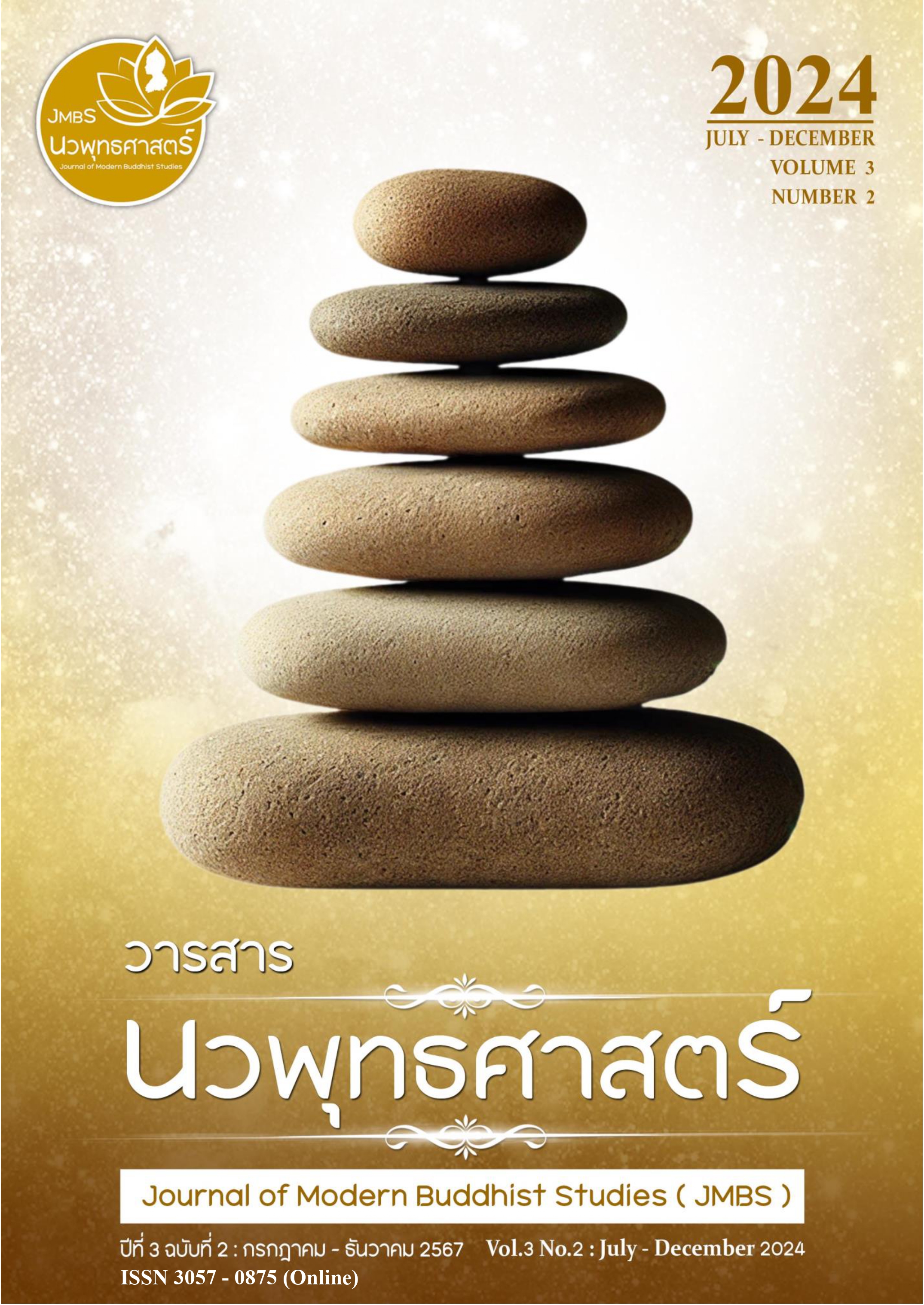การวิเคราะห์กระบวนการสร้างความสำเร็จในชีวิตตามหลักอธิษฐานธรรม
คำสำคัญ:
An Analysis of Adhiṭthãnadhamma, Success Construct, Principle of Adhiṭthãnadhammaบทคัดย่อ
งานวิจัยนี้ มีวัตถุประสงค์เพื่อศึกษาหลักอธิษฐานธรรมในคัมภีร์พระพุทธศาสนาสร้างความสำเร็จในชีวิตของบุคคล และเพื่อวิเคราะห์ความสำคัญของกระบวนการสร้างความสำเร็จในชีวิตของบุคคลตามหลักอธิษฐานธรรมในคัมภีร์พระพุทธศาสนา การวิจัยครั้งนี้เป็นการวิจัยแบบเชิงคุณภาพ โดยใช้เทคนิคการวิเคราะห์เนื้อหาประกอบบริบท เพื่อนำเสนอกระบวนการสร้างความสำเร็จในชีวิตตามหลักอธิษฐานธรรมดังนี้ ผลการวิจัยพบว่า
1) การศึกษาหลักอธิษฐานธรรมในคัมภีร์พระพุทธศาสนาสร้างความสำเร็จในชีวิตของบุคคล พบว่า ความสำเร็จในชีวิตตามหลักพระพุทธศาสนา ประกอบด้วย หลักความเจริญ ปฏิบัติตามหลักธรรมที่จะนำชีวิตไปสู่ความเจริญรุ่งเรือง, หลักความสำเร็จ ปฏิบัติตามหลักธรรม ที่จะนำไปสู่ความสำเร็จแห่งกิจการนั้นๆ ประกอบด้วย 1) ด้านปัญญาธรรม เป็นความคิดเห็นตามความจริง 2) ด้านสัจธรรม เป็นสิ่งสำคัญต่อมนุษย์ 3) ด้านจาคะธรรม การสินตัดใจ หรือตัดกรรมสิทธิ์ของตน 4) ด้านอุปสมธรรม ฐานความมั่นคงให้ประสบผลสำเร็จของชีวิต สามารถดำเนินชีวิตของตนเองให้บรรลุถึงจุดมุ่งหมาย
2) การวิเคราะห์ความสำคัญของกระบวนการสร้างความสำเร็จในชีวิตของบุคคลตามหลักอธิษฐานธรรมในคัมภีร์พระพุทธศาสนา พบว่า 1) กระบวนการด้านปัญญา 4 องค์ประกอบ คือ ปัญญาพัฒนาศักยภาพที่จะมีความสุข ยึดหลักทางสายกลางในการแก้ไขปัญหาด้วยหลักคำสอนทางพระพุทธศาสนา 2) กระบวนการด้านสัจจะ โดยเน้นการพูดพอประมาณ พูดถูกกาล เพราะพูดถูกกาลอันควร คือพูดตามกำหนดกาลที่ควรพูด 3) กระบวนการด้านจาคะ การแก้ปัญหาในแบบองค์รวม และเสียสละเพื่อส่วนรวม และ 4) กระบวนการด้านอุปสมะ เป็นการประยุกต์ใช้กระบวนธรรมประกอบด้วย ฆราวาสธรรม 4 สังคหวัตถุ 4 อิทธิบาท 4 และธรรมจักร 4 มาใช้ในการข่มจิตข่มใจ การรู้จักระงับอารมณ์เมื่อมีความไม่พอใจเกิดขึ้น
เอกสารอ้างอิง
กนิษฐา หลักฐาน เจษฎา เทพศร และ ดร.ประสิทธิ์ เขียวศรี (2566). แนวทางการพัฒนาและส่งเสริมการจัดการเรียนรู้ในศตวรรษที่ 21: กรณีศึกษาบริบทในพื้นที่. สำนักงานศึกษาธิการภาค 8. สืบค้นข้อมูลจาก https://reo8.moe.go.th/wp-content/uploads/2022/05/
พระครูเมตตาสารคุณ (2554). “การศึกษาหลักอธิษฐานธรรมในการสร้างความมั่นคงของชีวิต”. วิทยานิพนธ์พุทธศาสตรมหาบัณฑิต. บัณฑิตวิทยาลัย: มหาวิทยาลัยจุฬาลงกรณราชวิทยาลัย.
พระเทพสุวรรณโมลี (2552). เสียงพระเสียงเพลง. พิมพ์ครั้งที่ 3. กรุงเทพมหานคร: หจก. สามลดา.
พระธรรมโกศาจารย์ (2551). ความสำเร็จแห่งชีวิต. กรุงเทพมหานคร: ธรรมสภานุสรณ์.
พระธรรมโกศาจารย์ (2550). คู่มือดับทุกข์. กรุงเทพมหานคร: ธรรมสภา.
พระธรรมสิงหบุราจารย์ (2548). หลักประกันชีวิตทุกลมหายใจใช้เวลาให้เป็นประโยชน์. กรุงเทพมหานคร: ธรรมสภา.
พระบุญลัท ปุญฺญวนฺโต (2563). “การสร้างความสำเร็จในชีวิตตามหลักอธิษฐานธรรม”. วิทยานิพนธ์ ศาสนศาสตรมหาบัณฑิต สาขาวิชาพุทธศาสน์ศึกษา. บัณฑิตวิทยาลัย: มหาวิทยาลัยมหามกุฏราชวิทยาลัย.
พระพรหมคุณาภรณ์ (2554). พจนานุกรมพุทธศาสตร์ ฉบับประมวลธรรม. พิมพ์ครั้งที่ 16. กรุงเทพมหานคร: สหธรรมิก.
พระพรหมมังคลาจารย์ (2550). ธรรมครองชีวิตธรรมะนำแสงสว่างสู่ชีวิตใหม่. กรุงเทพมหานคร: ธรรมสภา.
พระภูริวัทน์ ฐิตปุญฺญฺ (2549). “ศึกษาเปรียบเทียบวิธีการเข้าถึงความจริงของพระพุทธศาสนากับวิทยาศาสตร์ ศึกษากรณีปฏิจจสมุปบาท”. วิทยานิพนธ์ศาสนศาสตรมหาบัณฑิต สาขาปรัชญา. บัณฑิตวิทยาลัย: มหาวิทยาลัยมหามกุฏราชวิทยาลัย.
พระมหาทองคูณ ธีรปญฺโญ (2549). “การศึกษาเปรียบเทียบเรื่อง นิพพานในพระพุทธ ศาสนาเถรวาทมหานิกายโยคาวจารและวัดพระธรรมกาย”. วิทยานิพนธ์พุทธศาสตรมหาบัณฑิต. บัณฑิตวิทยาลัย: มหาวิทยาลัยมหาจุฬาลงกรณราชวิทยาลัย.
พระอธิการสุรศักดิ์ สุขุมาโล และ อนุวัต กระสังข์ (2562). “การใช้หลักธรรมคำสอนของพระพุทธเจ้าเพื่อลดปัญหาความรุนแรงในสังคมไทย”. วารสารเสลภูมิวิชาการ. 5(2) (กรกฎาคม-ธันวาคม).
พีรพัฒน์ ศุภลักข์ (2550). คัมภีร์ชีวิต คิดอย่างพระพุทธเจ้าแล้วเราจะไม่ทุกข์. กรุงเทพมหานคร: ชบาพับลิชชิ่งเวิร์กส์.
พุทธทาสภิกขุ (2547). ศาสนา ดนตรี กวี ศิลปะ. กรุงเทพมหานคร: สำนักพิมพ์สุขภาพใจ.
ภัฏชวัชร์ สุขเสน (2561). อธิษฐานธรรม: หลักความมั่นคงของมนุษย์. “วารสารวนัมฎองแหรกพุทธศาสตรปริทรรศน์”. 5(1) (มกราคม-มิถุนายน).
มูลนิธิพระราชศรัทธา (2537). พระธรรมเทศนา กัณฑ์ที่ 29 เรื่อง อธิษฐานธรรมค้ำความดีมั่นคง. กรุงเทพมหานคร: โรงพิมพ์เลี่ยงเซี่ยง.
ราชบัณฑิตยสถาน (2546). พจนานุกรมฉบับราชบัณฑิตยสถาน พ.ศ.2542. กรุงเทพมหานคร: นานมีบุ๊คส์พับลิเคชั่นส์.
ศุภวรรณ พ.พรรณวงศ์ กรีน (2548). คู่มือชีวิตภาคศีลธรรม. พิมพ์ครั้งที่ 3. ปทุมธานี: สกายบุคส์.
สมเด็จพระญาณสังวร สมเด็จพระสังฆราชสังฆปรินายก (2535). ความจริงที่ต้องเข้าใจ. พิมพ์ครั้งที่ 2. กรุงเทพมหานคร: มหามกุฏราชวิทยาลัย.
สมเด็จพระพุทธโฆษาจารย์ (2564). พุทธธรรม ฉบับปรับปรุงและขยายความ. พิมพ์ครั้งที่ 31. กรุงเทพมหานคร: มหาวิทยาลัยเอเชียอาคเนย์.
สำนักงานเลขานุการกรม สำนักงานสถิติแห่งชาต (2567). 100 คำสอน สมเด็จพระสังฆราช: บทความคุณธรรม. สืบค้นข้อมูลจาก https://ethics.nso.go.th/index.php/moral/29-100.
สำนักมาตรฐานการพัฒนาสังคมและความมั่นคงของมนุษย์ (2550). ความมั่นคงของมนุษย์ประเทศไทย ปี 2549. พิมพ์ครั้งที่ 2. กรุงเทพมหานคร: กระทรวงพัฒนาสังคมและความมั่นคงของมนุษย์.
เสถียรพงษ์ วรรณปก (2549). นิทานมงคลธรรม. กรุงเทพมหานคร: ธรรมสภา.
ไฟล์ประกอบ
เผยแพร่แล้ว
รูปแบบการอ้างอิง
ฉบับ
ประเภทบทความ
สัญญาอนุญาต
ลิขสิทธิ์ (c) 2024 วารสาร นวพุทธศาสตร์

อนุญาตภายใต้เงื่อนไข Creative Commons Attribution-NonCommercial-NoDerivatives 4.0 International License.






